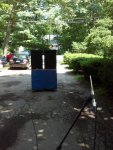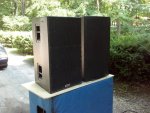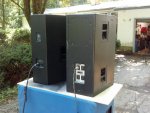Well this was fun, and loud. Since I acquired a pile of KF650s and own a pile of Fulcrum DX1565s, I figured I'd do a quick shootout to see how loud they got.
First up, we have the old school KF650e with a single 15" woofer, a 10" horn loaded mid, and a 2" horn loaded HF. All pretty standard components. As seen in the other thread, I was biamping the speaker undergoing testing with a Crown IT5000HD with my custom IIR presets and the recommended high pass of 80Hz. The KF650 weighs about 150 pounds and is not pole mountable, making it relatively difficult to deploy, especially as one person.
Second up, we have the Fulcrum DX1565. This is the new kid on the block, with a 15" woofer and a 15" coax driver with 1.5" exit HF horn. The Fulcrums were running the provided FIR presets, also with an 80Hz high-pass. The DX15 series weighs about 90 pounds and is pole mountable, meaning I can do a show myself without a problem. I routinely stack and unstack these on stands with no help.
First impressions: playing a variety of music switching back and forth quickly, the KF650 sounded much more mid-heavy than the DX. By mid-heavy I'm talking in the 600-1k range. With the KF I was not really able to EQ out the sound. The overall SPL from the boxes sounded similar when driven with the same signal and the output meters being in the same position on the amps - so the sensitivity is pretty similar, and so is the power handling. Both can handle the IT5000HD @ clip without any trouble, at least with 6dB crest factor Smaart-generated pink noise.
Controls: to try to get things to be consistent during measurements, I placed an Audix TM1 equidistant from each box, with both boxes situated side-by-side pointed at the mic. Both boxes remained plugged into their respective amps during testing as to not interfere with the other speaker's measurements (an unplugged speaker can affect a speaker next to it in funny ways). My measurement environment was not great, it was just in the driveway outside my shop area. There were some reflections from a nearby trailer, but nothing too bad, at least not that would affect these results too much. The mic was placed about 25 feet from the stack and the mains were sitting on top of one of my SRX728S subs. See pictures for placement specifics:



So, to do a max output measurement, I had to see how loud each box would go when playing pink noise. The IT5000HD might have been slightly underpowered for this, as neither box hit limit before the amp clipped. Here is the picture of both boxes relating their maximum outputs:

I bet you can guess which box is which - before each measurement was taken, I ran 'AutoSm' to get things as close as possible. The KF650e has a TON of phase wrap versus the DX1565. The KF650e seemed to have a tad bit more output above about 3k, but that may have been a result of EQ choices in their DSP settings. The DX1565 has a ton more output below 200Hz due to the double 15s going all the way down.
Here are pictures of the amps when they were at their maximum outputs. Due to the nature of pink noise, it's a dynamic stimulus, and the instant I took these screenshots the DX1565 (right amp) was reading a higher level than the KF650e (left amp). Both measurements, though, were taken just as the amp hit clip, as indicated by the big red clip light at the top:


Thoughts:
The KF650 is 60 pounds heavier and not pole-mountable, but is just about as loud. With a larger amplifier, the difference between the boxes may have been more apparent, but on paper and in reality, the main portion of the outputs of these cabinets are within about 2dB of each other. The Fulcrum box definitely wins below 200Hz, and blows away the KF650 when using the Full Range presets, which run both boxes down to 45Hz or so.
Also, the sound quality difference between the two is staggering. Even though the magnitude traces are pretty close, they sound so different. If the KF650 was running the Gunness FIR presets I bet it would sound vastly better.
Overall, I like both boxes, but I'm sticking to my DX1565s for now.
First up, we have the old school KF650e with a single 15" woofer, a 10" horn loaded mid, and a 2" horn loaded HF. All pretty standard components. As seen in the other thread, I was biamping the speaker undergoing testing with a Crown IT5000HD with my custom IIR presets and the recommended high pass of 80Hz. The KF650 weighs about 150 pounds and is not pole mountable, making it relatively difficult to deploy, especially as one person.
Second up, we have the Fulcrum DX1565. This is the new kid on the block, with a 15" woofer and a 15" coax driver with 1.5" exit HF horn. The Fulcrums were running the provided FIR presets, also with an 80Hz high-pass. The DX15 series weighs about 90 pounds and is pole mountable, meaning I can do a show myself without a problem. I routinely stack and unstack these on stands with no help.
First impressions: playing a variety of music switching back and forth quickly, the KF650 sounded much more mid-heavy than the DX. By mid-heavy I'm talking in the 600-1k range. With the KF I was not really able to EQ out the sound. The overall SPL from the boxes sounded similar when driven with the same signal and the output meters being in the same position on the amps - so the sensitivity is pretty similar, and so is the power handling. Both can handle the IT5000HD @ clip without any trouble, at least with 6dB crest factor Smaart-generated pink noise.
Controls: to try to get things to be consistent during measurements, I placed an Audix TM1 equidistant from each box, with both boxes situated side-by-side pointed at the mic. Both boxes remained plugged into their respective amps during testing as to not interfere with the other speaker's measurements (an unplugged speaker can affect a speaker next to it in funny ways). My measurement environment was not great, it was just in the driveway outside my shop area. There were some reflections from a nearby trailer, but nothing too bad, at least not that would affect these results too much. The mic was placed about 25 feet from the stack and the mains were sitting on top of one of my SRX728S subs. See pictures for placement specifics:



So, to do a max output measurement, I had to see how loud each box would go when playing pink noise. The IT5000HD might have been slightly underpowered for this, as neither box hit limit before the amp clipped. Here is the picture of both boxes relating their maximum outputs:

I bet you can guess which box is which - before each measurement was taken, I ran 'AutoSm' to get things as close as possible. The KF650e has a TON of phase wrap versus the DX1565. The KF650e seemed to have a tad bit more output above about 3k, but that may have been a result of EQ choices in their DSP settings. The DX1565 has a ton more output below 200Hz due to the double 15s going all the way down.
Here are pictures of the amps when they were at their maximum outputs. Due to the nature of pink noise, it's a dynamic stimulus, and the instant I took these screenshots the DX1565 (right amp) was reading a higher level than the KF650e (left amp). Both measurements, though, were taken just as the amp hit clip, as indicated by the big red clip light at the top:


Thoughts:
The KF650 is 60 pounds heavier and not pole-mountable, but is just about as loud. With a larger amplifier, the difference between the boxes may have been more apparent, but on paper and in reality, the main portion of the outputs of these cabinets are within about 2dB of each other. The Fulcrum box definitely wins below 200Hz, and blows away the KF650 when using the Full Range presets, which run both boxes down to 45Hz or so.
Also, the sound quality difference between the two is staggering. Even though the magnitude traces are pretty close, they sound so different. If the KF650 was running the Gunness FIR presets I bet it would sound vastly better.
Overall, I like both boxes, but I'm sticking to my DX1565s for now.
